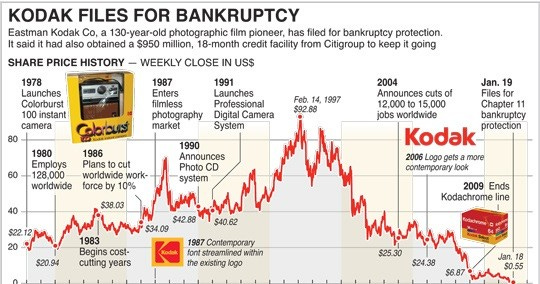The Hidden Signs of a Dying Business: What Wall Street Won't Tell You
#39 A Young Professionals Weekly Investing Insights
What if you could spot a failing business before your portfolio takes a hit?
After analysing over 200 business failures - from retail giants to tech darlings - I've uncovered a pattern that could save your hard-earned money.
The best part?
You don't need to be a Wall Street analyst to spot these patterns.
You just need to know where to look.
Why Most Investors Miss the Warning Signs
Here's a surprising truth: 90% of business failures showed clear warning signs up to 24 months before their collapse.
Yet most investors miss them because they're looking at the wrong things.
They focus on quarterly earnings reports and stock prices - while the real story is hiding in plain sight.
Think about Blockbuster.
While investors were still counting store locations and rental revenues, they missed the real warning signs:
Customers were increasingly frustrated with late fees
Netflix was gaining popularity, but Blockbuster dismissed it
Top talent was leaving for tech companies
The company was loading up on debt instead of investing in digital
Store traffic was declining, but they kept opening new locations
By the time these signs became obvious in the financial statements, it was too late.
The Death Spiral Formula: What Really Kills Businesses
When a business shows 4 or more of these signals, there's a high chance of serious trouble within 24 months. Let's break down each one:
1. Margin Decay
What it means is the company is making less money on each sale.
For example think about traditional retailers. When they start offering bigger and bigger discounts just to keep customers coming in, that's margin decay in action.
Warning signs:
Constant sales and promotions
"Special offers" becoming the norm
Rising costs without ability to raise prices
Heavy discounting to match competitors
A well-known example of margin decay can be seen with Sears - once a dominant force in the American retail industry.
They struggled with heavy discounting and constant promotions to compete with newer - more agile competitors like Walmart and Amazon.
2. Talent Exodus
Taken exodus is when smart people are jumping ship.
Before Nokia's mobile phone business collapsed, their best engineers and designers were leaving for Apple and Google. They - the people from the inside - knew something wasn't right.
Warning signs:
Senior executives leaving "to pursue other opportunities"
Negative employee reviews on Glassdoor
Increasing job postings for key positions
LinkedIn shows employees moving to competitors
3. Rising Debt
This is when the company needs to borrow more just to keep running.
Debt can be a great engine of growth - but when companies use it to run daily operating activities, trouble isn’t far.
For example - before Toys "R" Us went bankrupt they were borrowing money to pay for daily operations, not for growth.
Warning signs:
Increasing debt without corresponding growth
New loans to pay off old ones
Credit rating downgrades
Rising interest expenses
4. Innovation Freeze
Sometimes it can happen that the company stops creating new things and starts copying competitors.
And when a company loses its identity - that’s usually not a good sign.
Take Kodak - they invented digital photography but refused to develop/ improve it because they were too focused on protecting their film business.
Warning signs:
Products looking identical to competitors
Falling R&D spending
Few new product launches
Playing catch-up instead of leading
5. Customer Flight
When customers are slowly but surely leaving you’re in for problems.
At the end of the day - your company and product is nothing without people buying it.
Before BlackBerry's collapse, users were switching to iPhones and Android phones one by one. The thing is it actually started slow - but became an avalanche soon enough.
Warning signs:
Declining repeat purchases
Falling customer satisfaction scores
Increasing customer complaints
Lower social media engagement
The Simple Way to Check Any Company's Health
You don't need fancy software or a finance degree. Just 15 minutes a month checking these areas:
1. Financial Health Check
Look for:
Revenue growth compared to last year
Profit margins trending up or down
Cash flow (is it positive or negative?)
Debt levels (are they growing?)
Use free tools like Yahoo Finance or Google Finance. Look at the "Financial Statements" section. If you see multiple (5-6) consecutive quarters of declining margins, that's a red flag.
2. Customer Happiness Check
Happy customer = Happy business
Look for:
App store ratings
Social media sentiment
Online reviews
Customer complaint patterns
Just Google "[Company Name] customer reviews" and read the most recent ones. Look for patterns, not individual complaints
3. Employee Satisfaction Check
Look for:
Glassdoor ratings and trends
LinkedIn employee movement
Indeed.com company reviews
Management turnover
On Glassdoor - don't just look at the rating. Read recent reviews and look for recurring themes.
The Three Deadly Patterns That Predict Failure
1. The Death Triangle
This pattern showed up in 90% of bankruptcies 12 months early:
Margins ⬇️ Debt ⬆️ Cash ⬇️
How it works:
Margins start falling
Company borrows money to compensate
Cash flow shrinks as debt payments increase
More borrowing needed
Spiral continues until bankruptcy
This exact pattern played out at Sears. They saw falling margins, borrowed more money, which led to higher interest payments, which ate into their cash flow, forcing them to borrow even more.
2. The Culture Collapse
When you see these signs together, trouble is brewing:
Key talent leaving: Leaders and top performers quit first
Glassdoor ratings drop: Especially when long-term employees post negative reviews
Innovation slowdown: Fewer new products, more "me too" offerings
Cost obsession: Cutting corners becomes the norm
Mission drift: The company loses sight of what made it successful
Before WeWork's implosion for example, they shifted from their original mission of "creating community" to just chasing growth at any cost.
The culture shifted from innovative to chaotic.
3. The Customer Exodus
Once this starts, recovery is rare:
Social mentions decline: Less organic buzz
Review scores fall: Especially from loyal customers
Customer service deteriorates: Budget cuts here are a huge red flag
Price sensitivity increases: Customers no longer see the value
Retention rates drop: Existing customers leave
Complaint volume rises: And the nature of complaints changes from minor issues to core problems
One last example - Remember MoviePass?
The warning signs were all there: customers complaining about service changes, rising prices, and basic functionality issues.
Key Lessons to Remember
Problems Compound:
Small issues become big ones
Warning signs usually multiply
Speed of decline accelerates
Culture Predicts Future:
Happy employees = happy customers
Innovation requires good culture
Leadership sets the tone
Customer Behavior Tells the Truth:
Watch what they do, not what they say
Declining loyalty is a huge red flag
Price sensitivity signals problems
Debt Is a Double-Edged Sword:
Good debt fuels growth
Bad debt masks problems
Debt problems compound quickly
Ready to take your investing journey to the next level?
Whenever you’re ready, here's how I can help:
"How to Grow Your Money Effortlessly with High-Performing ETFs": My comprehensive guide for busy professionals who want to build wealth without the stress of stock-picking.
Learn how to:
Create a high-performing ETF portfolio in less than a day
Select ETFs that provide safety and are future-ready
Automate your investments for truly hands-off wealth building
Plus, get exclusive access to:
Custom ETF Portfolio Tracker
An ETF Selection Checklist
Market Downturn Survival Guide
Private community of like-minded investors
and 11+ other bonus resources (including access to 16+ free investing ebooks).
Don't let another day pass watching your savings stagnate.
Join thousands of readers who are already on their path to financial freedom.
[Click here to get started today and save 70% with our special subscriber discount!]
Oh and here are some other newsletters I enjoy reading and recommend:
This newsletter is for informational purposes only and is not intended as financial advice. The insights provided are illustrative and should not be the sole basis for investment decisions. Readers should conduct their own research and consult professional advisors before investing. The authors and publishers are not liable for any financial losses resulting from actions taken based on this content. Investing in the stock market involves risk, including potential loss of capital.










Great article! I know some of these things are more qualitative, but it'd be nice to have a screener for those of these that can be quantified, at least as a starting point. It's hard to keep track of all of these across 20-30 open positions.